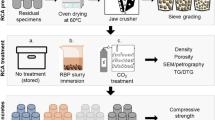Abstract
Since sustainable and environmentally friendly structural concrete has received special attention, structural light-weight basalt concrete has gained popularity. However, it is rarely used in the construction industry domestically. Basic porous basalt aggregates, are introduced to replace acidic silica aggregates with control of shape, size, and porosity for less dense parent basalt aggregate recycled PBR. A new foaming agent is introduced with a new non-traditional manufacturing process that produces a “green” construction material that is environmentally friendly. An experimental investigation is carried out for the addition of aluminum hydroxide at a temperature of 1260 °C to liquid state PBR by a weight percentage of approximately 30 wt% for 35 min. The PBR sample is then either cooled to room temperature and/or reheated at 985 °C for 20 min for rheocasting from liquid or thixocasting from solid, in which aluminum dioxide (1010 wt%) is added. Rheocasting and thixocasting processes established a new structurally lightweight, low-cost, domestic, and high-performance material, which is manufactured porous basalt aggregate (MPBA used to replace silica coarse gravel. Then a series of samples are prepared and subjected to chemical, physical, and mechanical tests. These tests are carried out to assess and determine the properties of the manufactured PBA. The results of using the foaming agent on PBR reduce its density from 2.87 to 1.82 g/cc. MPBA is used in a concrete mix to prepare concrete cubes as samples to be subjected to the compression test. The compression test results vary from 25 to 47 MPa. The non-traditional foaming methodology caused a tremendous reduction in density that produced LWC with structural properties. The MPBA can be utilized as a replacement for course aggregate in concrete mixtures, adding the value of sustainable, severe acidic exposure and high energy absorption to concrete.










Similar content being viewed by others
References
Transportation Research Board (1997) Washington, DC, Basalt fiber composite reinforcement for concrete
Zhao M, chen M, li J, Law D (2018) An expermintal study on strength and toughness of steel fiber rienforcment expanded-shale lightweight concrete. Sci Direct 183:48–54
Anna Mod (2011) Building modern huston. Arcadia Publishing, Huston
Morgan Rhett (2016) Renovation to universty clubappartment, manson house long overdue. Tusla world, Manson
D James (2017) Inwood manor, san felipe 70
RG Morgan (1976) History and experiance with concrete ships. Hisory of construction materials
Zareef Mohamed Ahmed, Mohamed (2010) Conceptual and structural design of lightweight and infra-lightweight concrete. Technical Universty of Berlin, Berlin
Aghaee K, Yazdi MA (2014) Waste steel wires modified structure light weight concrete. Sci ELO, Brasil
FM Tehrani (2020) Service life pridection of structral lightweight concrete using transport properties. ESCSI
M. Neglo (2001) Classification of lightweight concrete with respect to density and strength. Material Science
Ynlo Tommy, Ali Shazim (2020) Effect of lightweight aggregate on the mechanical properties and brittleness of lightweight aggregate concrete. Constr build mater 35:149–158
Ahmed Wisal, Lim CW (2021) Production of sustainable and structural fiber reinforced recycled aggregate concrete with improved fracture properties: a review. J Clean product 279:123832
Elshazli Mohamed T, Ramirez Kevin, Ibrahim Ahmed, Badran Mohamed (2022) Mechanical Durability and Corrosion Properties of Basalt Fiber Concrete. Fibers 10(2):2079–6439
Binici Hanifi, Yardim Yavuz, Aksogan Orhan, Resatoglu Rifat, Dincer Aytac, Karrpuz Ali (2020) Durability properties of concretes made with sand and cement size basalt”. Sustain Mater Technol 23:e00145
Düzgün OA, Gül R, Aydin AC (2005) Effect of steel fibers on the mechanical properties of natural lightweight aggregate concrete. Mater Lett 59(27):3357–3363
Ghassan Al-Chaar, Allison Brandvold, Andrij Kozych, and William Mendoza (2023) 4D printing structures for extreme temperatures using metakaolin based geopolymers, Construction Engineering Research laboratory
Author information
Authors and Affiliations
Corresponding author
Ethics declarations
Conflicts of interest
All authors declare that they have no conflicts of interest.
Ethical approval
This article does not contain any studies with human participants or animals performed by any of the authors.
Informed consent
For this type of study formal consent is not required.
Rights and permissions
Springer Nature or its licensor (e.g. a society or other partner) holds exclusive rights to this article under a publishing agreement with the author(s) or other rightsholder(s); author self-archiving of the accepted manuscript version of this article is solely governed by the terms of such publishing agreement and applicable law.
About this article
Cite this article
Rabeeh, B.M., Mahfouz, S.Y., Elkafrawy, H.A. et al. Porous recycled basalt aggregate for sustainable, environmentally friendly concrete. Innov. Infrastruct. Solut. 9, 200 (2024). https://doi.org/10.1007/s41062-024-01485-7
Received:
Accepted:
Published:
DOI: https://doi.org/10.1007/s41062-024-01485-7




